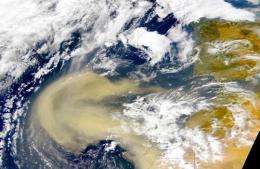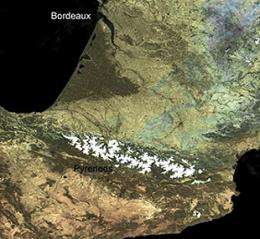The Flight of Migrating Microbes

Every day, millions of microorganisms reach Spain from the Sahara Desert and the Sahel region - by flying.
Louis Pasteur demonstrated back in 1861 that germs can move through the air, but it was only recently discovered that bacteria, funguses and viruses can travel thousands of kilometers stuck onto dust particles. Satellite images show clouds that come close to the size of the Iberian Peninsula.
For the first time, the international team on the Ecosensor project, funded by the BBVA Foundation, have analyzed these traveling microorganisms using molecular biology techniques. As well as identifying the species, they have found that they colonize high-mountain lakes in the Sierra Nevada and the Pyrenees, and that the phenomenon is escalating with climate change.
The "migration" of these microorganisms on African dust is most intense in spring and summer, and has been gathering momentum in recent years; at times multiplying their numbers ten times over. This is due, researchers say, to the drought afflicting the Sahel region for the last thirty years, itself a product of our changing climate.
An added spur is the loss of plant cover in Africa driven by changes in farming practices. It is reckoned that between 60 and 200 million tons of dust rise up from the Sahara every year; a material rich in nitrogen, phosphorous and iron with an important role in the growth of marine plankton, and even the fertilization of tropical forests.
Ecosensor brings together an international team of atmospheric physicists and biologists led by Isabel Reche, of the University of Granada, and Emilio O. Casamayor, from the Blanes Center for Advanced Studies. The molecular biology techniques these researchers use allow them to detect almost all the organisms present in a given sample, in contrast to earlier methods which Reche explains revealed "a good deal less than there really is".
The Canary Islands bear the brunt
That is why until now we could not even identify 0.1 percent of the 500 bacteria present in a liter of air, and had no inkling of how they might affect their "destination" ecosystems. The Saharan dust spreads across the whole planet, but the prevailing winds - from the east - mean the regions most affected are the Canary Islands and the Caribbean (see satellite photos).
Ecosensor researchers have taken air samples in the places where it is easiest to detect the rain of microorganisms, such as high-mountain lakes. "Such spots have barely been altered by local human activity" Reche remarks, " so they are invaluable for studying the incidence of invading airborne microorganisms blown in from remote sources".
The lakes chosen are located in Sierra Nevada and the Pyrenees, as well as the Alps (Austria), Argentinean Patagonia, the Bylot Islands in the Arctic (Canada), and the South Shetland archipelago (Antarctica).
The researchers suck out air, filter it and extract the DNA of the organisms present. "By analyzing the genes we can tell what microorganism they belong to," Reche continues. They also separate the microorganisms to ascertain which can reach the lakes alive.

The same life in Sierra Nevada, the Pyrenees and Mauritania
Their results, which have recently appeared in various scientific publications, show that Sierra Nevada and Pyrenean lakes harbor microorganisms "that we have also found in the soil in Mauritania", says Reche. "It is truly amazing".
Among the microorganisms identified are Pseudomonas - a Bacillus genus capable of colonizing a wide range of niches; Staphylococci - a genus that includes microorganisms present in human skin, and Acinetobacter, which contribute to the mineralization of the soil. In general terms, they are considered to be non-pathogenic for humans.
But how might the advent of these new microorganisms affect local ecosystems?
"The increase in dust load in pristine ecosystems, like high-mountain lakes, has major repercussions" explains Reche, "because with it come nutrients that fertilize the lakes and alter their microbial communities".
Some of these changes have harmful effects; indeed the dust may already be damaging the fauna and flora of some ecosystems. Caribbean corals, for instance, are suffering decline due to excess dust deposition.
Another big question is, how do microorganisms manage to stay biologically active after their journey? The dust travels at between 2000 and 4000 meters altitude, exposed to severe dryness and harmful radiation; not all the organisms found form spores, so they must have other defense mechanisms at their command.
One hypothesis mentioned by Reche is "an increase in the quantity of protective pigments, which adhere to the mineral particles, conferring a degree of protection".
Provided by Astrobio.net

















